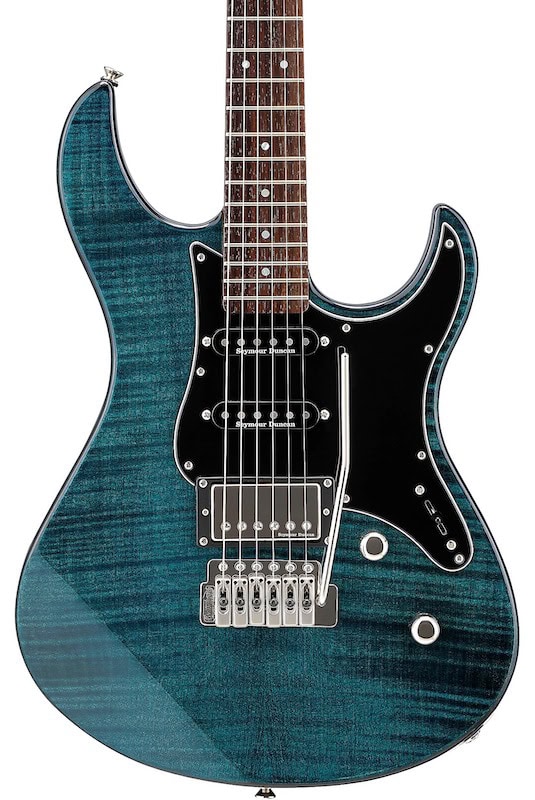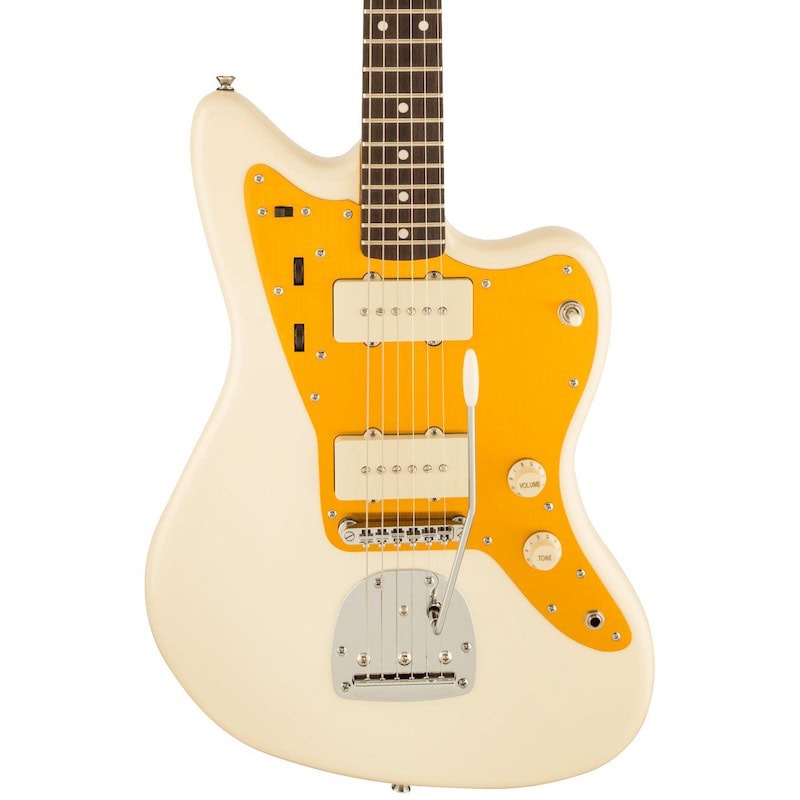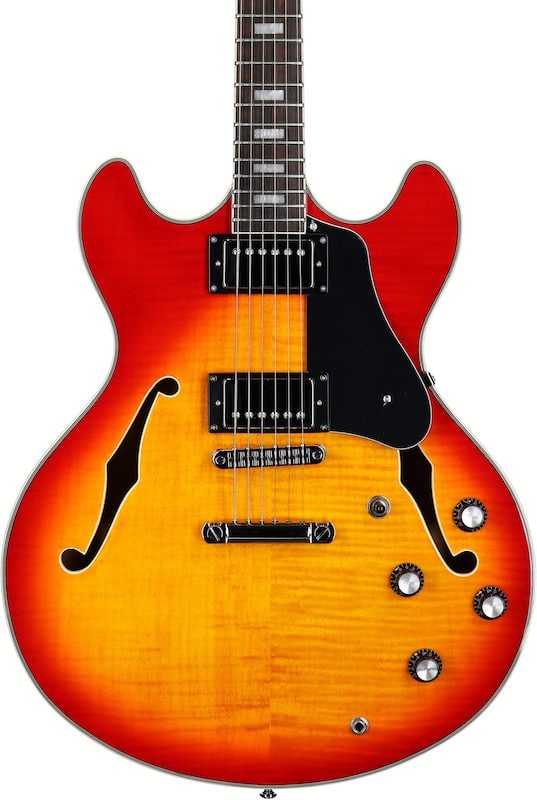It’s one of the most important steps in any guitar player’s career. The step up from a beginner instrument to a good, stage-worthy guitar. It’s the moment that you’re too good for starter-pack Squiers and department store-brand knockoffs.
The arrival of an intermediate guitar is a great moment for any guitar player, and a great intermediate guitar might well see any serious player through to a pro career. I’d know: I still play my first Epiphone Les Paul to this day!
Top 3 - Intermediate Electric Guitars
There are plenty of other reasons to pick up a mid-range instrument: sometimes you need a backup for your main pro-quality axe. Sometimes you want something less valuable to tour with. Sometimes it’s just about getting a new instrument within your price range!
Whatever the reason, I’ve played my fair share of intermediate instruments, and laid out a few of my favorites here.
Great Guitars, Reasonable Prices
Beginner guitar players (or their parents) often ask me: do guitars really have to be this expensive?
In short, yes. A pro-level instrument isn’t an expense: it’s an investment, and high-quality woods, parts, and craftsmanship aren’t cheap.
That’s not to say that there isn’t great value to be had in mid-range instruments, especially these days. When I was just starting out, anything under a thousand dollars wasn’t a great instrument. Guitar manufacturing technology has improved immeasurably since then, and there are some truly incredible mid-range guitars on the market now.
In fact, some of the guitars in this list rival much more expensive instruments for playability and sound quality. They save money for consumers by using more affordable woods, electronics, or manufacturing the guitar in cheaper countries like Mexico and China.
Getting a great midrange guitar really is about knowing what you want and what you’re willing to compromise on to get there.
Best Intermediate Electric Guitars - 6 Mid-range Picks!
1. Yamaha Pacifica PAC612VIIFM
Yamaha guitars are seriously underrated, especially in the US. They’re quality Japanese-built instruments that tend to emulate key features of well-known American guitar icons.
Their multi-purpose Les Paul imitator, the Revstar, is a great instrument, as is their SA hollowbody series.
This particular Pacifica is a great guitar.

Yamaha Pacifica PAC612 VIIFM
The flamed maple top feels a little out of place on a Strat-style instrument, but it looks great nonetheless. It is a laminate: there’s a visible seam between the two pieces of wood, but I’d argue that this accounts for much of this guitar’s accessible pricing.
The maple neck feels comfortable in my hand, a little narrower than on most modern Fenders. The alder body is comfortably lightweight, and the combo of these woods and Seymour Duncan single coils in the neck and middle position really give this guitar a convincing Stratocaster-like snap.
I love the feel of the rosewood fingerboard, too! I’m particularly impressed to see real rosewood on a guitar at this price point, and more than willing to endure the laminate top for a great tonewood on the fingerboard.
The Seymour Duncan humbucker in the bridge position is interesting, too. It pushes this guitar into bona fide superstrat territory: I plugged it into my Marshall and was able to conjure some seriously smoking 80s lead guitar tones. Coil-tapping it doesn’t exactly turn the humbucker into a Strat-style single-coil, however. It really just thins out the humbucker tone.
The Wilkinson tremolo, as expected, stubbornly stays in tune despite my best attempts at Van Halen-style dive bombs.
Overall, this might be one of the best value-for-money guitars on the market. Read our full review to know more about this beast of a mid-range guitar!
2. Squier J Mascis Jazzmaster
I know, it’s a Squier. I was at the Fender roadshow about ten years back, and heard one of their reps discussing the advancement of the Squier brand: they wanted to branch out from being student guitars, and become viable, affordable guitars for working musicians.
No guitar epitomizes this mentality like the J Mascis Jazzmaster. I’d hope that most players reading this might have at least a passing familiarity with Dinosaur Jr. That may not be the case these days, and in many ways the J Mascis Jazzmaster feels like the Stan Smith sneaker of guitars: the instrument bearing his name has eclipsed the man himself.
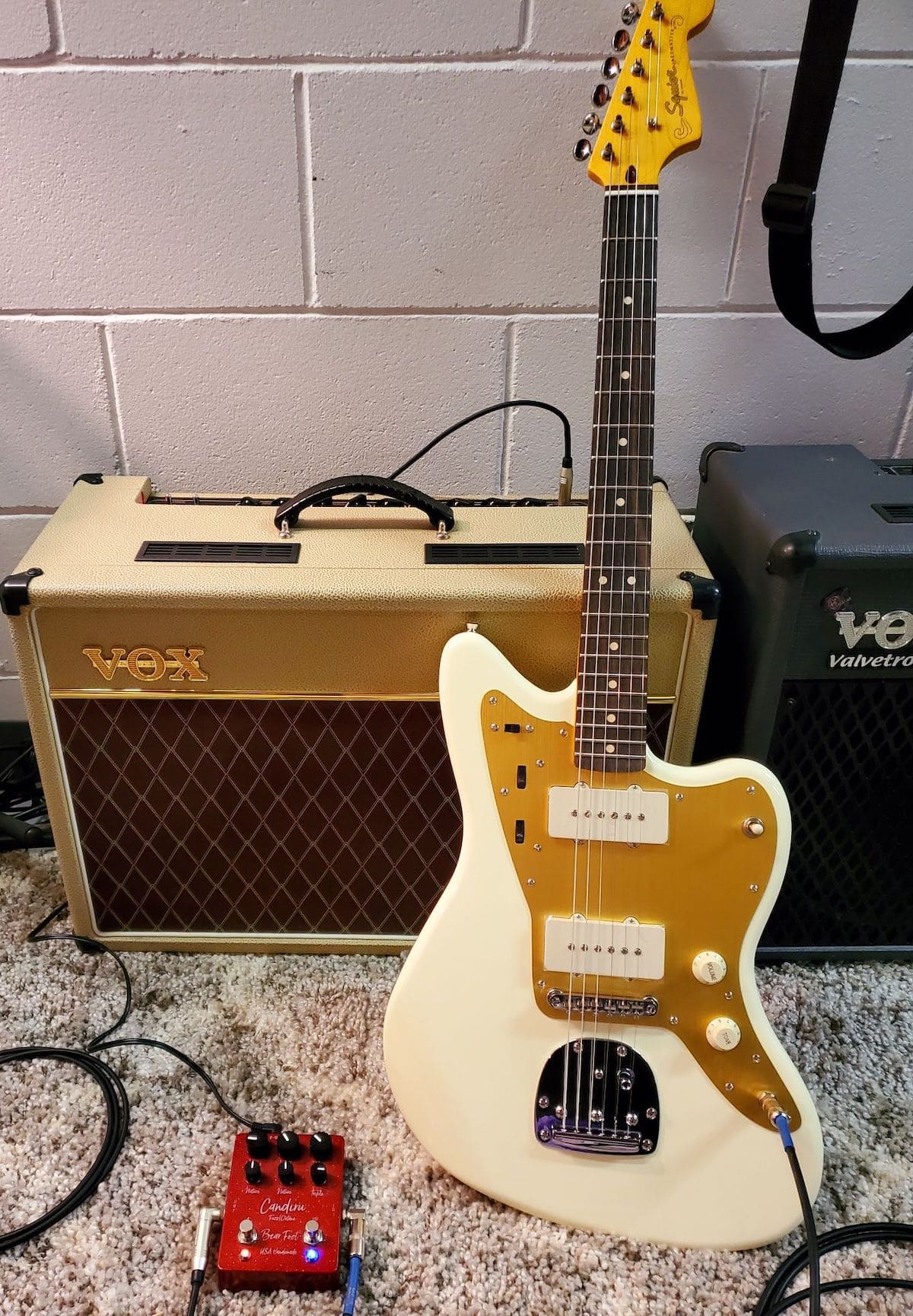
Squier J Mascis Signature Jazzmaster
First things first: the cream-and-gold color scheme of this guitar is pure, classy cool. I’ve played these guitars dozens of times, and seen dozens of them at gigs big and small. They look great on every stage.
The neck is a classic comfortable Fender C profile. I’m pretty accustomed to this neck profile, and it feels almost as if it plays itself. The maple is nicely lightweight and feels great in my hand. The satin finish on the neck feels nice and smooth, and contributes to the lower price point on this guitar.
I’m inclined to think the satin finish on the neck will harden into something closer to gloss over the course of a few years of heavy playing, as it has on all my satin necks. That’s a good thing: playing in a neck is great fun!
The laurel fingerboard is a little dry out of the box, but it’s nothing some lemon oil won’t fix. The jumbo frets encourage a much lighter touch, and therefore facilitate some very comfortable shredding moments. I got to run through some rapid country licks with serious ease while playing this guitar.
The single-coil pickups look like Gibson P90s, but they’re closer in spirit to a warm Telecaster sound. The Jazzmaster, when plugged in, offers a fatter, warmer version of classic Tele tone. It reminds me a lot of the tone from the intro riff of Chris Stapleton’s version of “Tennessee Whiskey.”
The control layout, for someone like me accustomed to simple Les Paul controls, does take some getting used to.
The switch on the upper horn selects between a warmer “rhythm” tone and a brighter, more distortion-friendly “lead” tone. The rhythm circuit’s tone and volume knobs are, in fact, the thumbwheels situated above the pickups. The normal tone and volume knobs are actually master tone and volume.
The rhythm/lead selector effectively turns off the bridge pickup, regardless of pickup selector position.
While this is more fiddly than I’d like for live use, I can’t argue with the range of tones it produces. It sounds great clean, at breakup, or in full-bore Dinosaur Jr distortion.
This is a guitar that could comfortably handle the most varied of cover gigs: if you have to play “Chattahoochee” and “Smells Like Teen Spirit” at the same gig, this is the guitar for you.
3. Schecter Solo-II Standard
It looks like a Les Paul, but it’s built like a shredder’s Superstrat. The Schecter Solo-II Standard is an awesome hard rock and heavy metal machine simply built to shred.
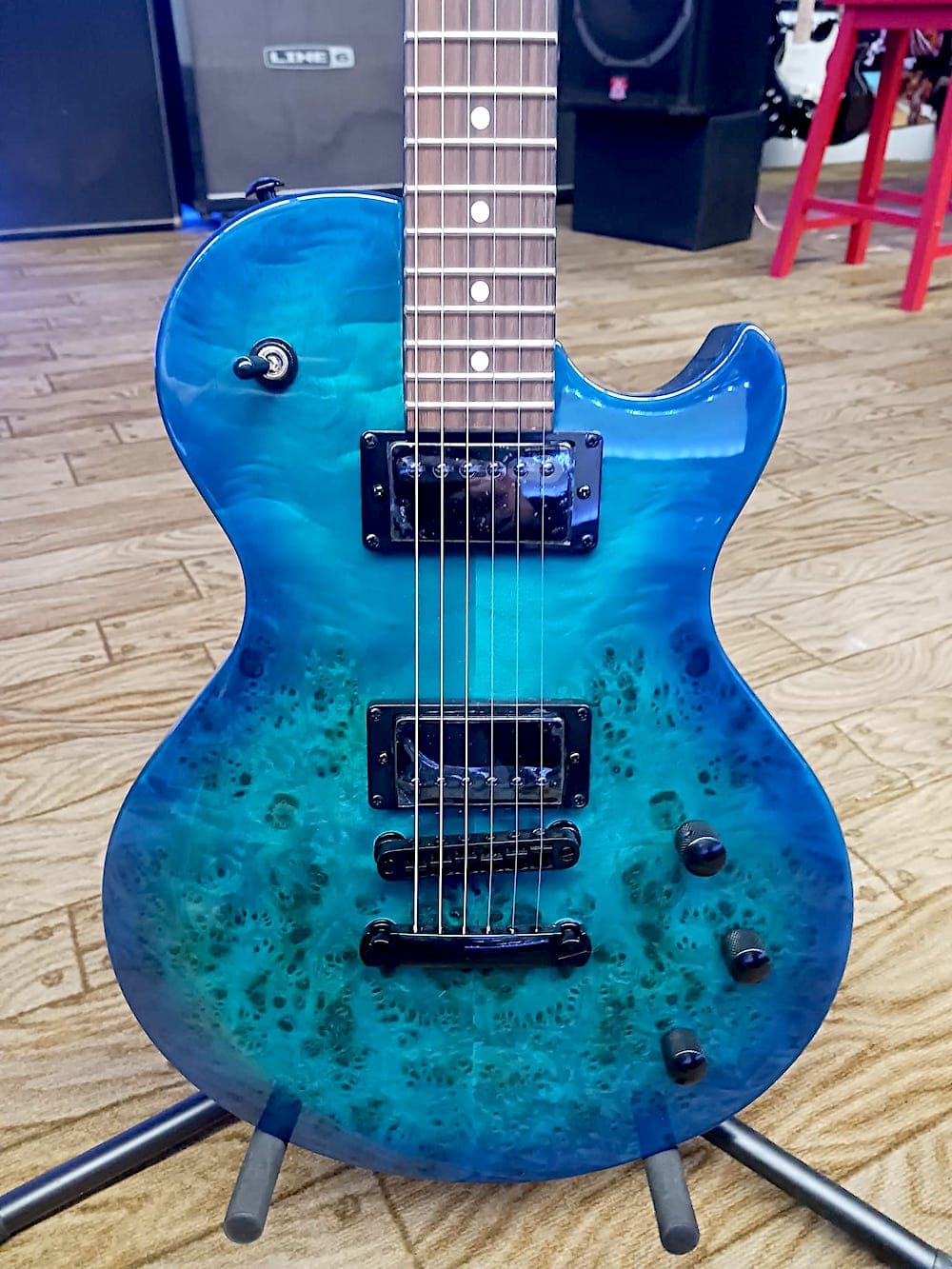
Schecter Solo-II Standard
First things first: it looks great. The laminate burled top is a cheaper wood than, say, a solid maple cap. It isn’t nearly as pretty as flame maple. It can’t be used for acoustic guitars. Schecter’s answer to this problem is to put an eye-catching blue finish and use it for their electric guitar! This, and a lack of upper-tier Les Paul embellishments like body and fingerboard binding keep the price of this guitar at a very affordable level.
The maple neck is pleasantly light, and shred-ready skinny. It really encourages those stretches and lightning-fast runs. The passive pickups offer reasonably good cleans: nothing I’d use for a country gig, but fine for clean passages in a hard rock context. They sound noticeably better with some 80s style chorus and compression applied.
With distortion, these pickups roar to life. I couldn’t resist playing some Avenged Sevenfold legato licks! This guitar is built to rock, and it really delivers rock tone in spades. It sounded particularly good in Drop D, with plenty of chunk and chug for powerful, uncompromising riffage.
However, I like to clean up my driven tones by rolling down the volume knob. The master volume knob bleeds out some treble, making the rolled-down sound of this guitar a little muddier than I’d otherwise like.
I would be inclined to upgrade the pickups and possibly the factory tuners. They work just fine out of the box, but if I was to use this as a workhorse guitar, I would want to be assured of the tuning heads’ reliability.
Overall, however, this is a great guitar for heavier styles of music.
4. Epiphone Les Paul Custom
I’m a devoted Les Paul fan. I love the shape, the weight, and the sound. I’m also a big believer in the value of high-end Epiphones, especially their Les Pauls.
It should be no surprise that I love this Epiphone Les Paul Custom complete with Gibson-style open book headstock!
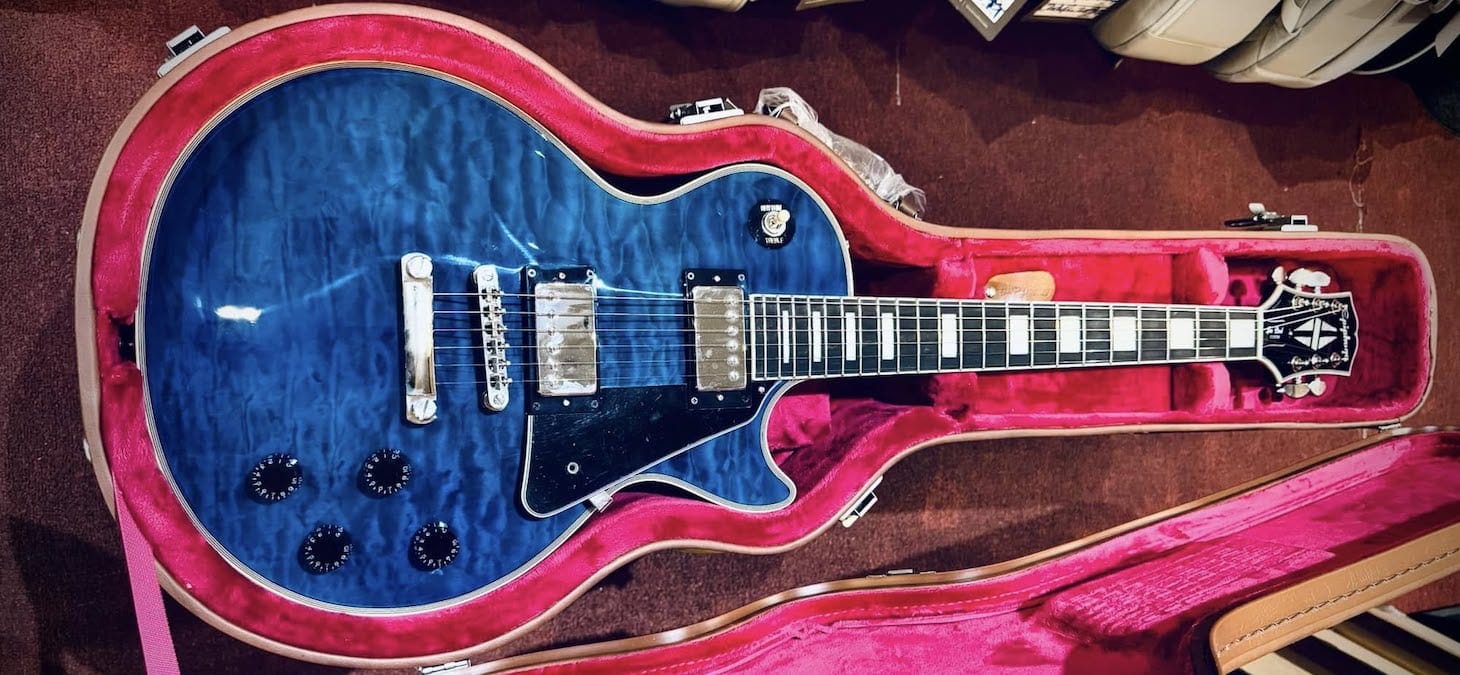
Epiphone Les Paul Custom Viper Blue
The guitar simply looks great. I’ve owned and played a few Epi Les Paul Customs over the years, and they certainly fit the bill: the original black Custom was designed to pair with a tuxedo. I feel like I could comfortably pull this guitar out in a black-tie pit gig and it wouldn’t look out of place. It’s all class.
The blue finish is lovely, but what really stands out is the dark, polished look of the ebony fretboard. That and the chrome hardware make this guitar a genuine head-turner.
The ebony fretboard feels good under my hands, although I do miss the bound ends of a Gibson Les Paul. It plays comfortably: certainly, the neck is fast enough to do the rapidfire licks at the end of the solo from “Paradise City.”
I’d always recommend playing a guitar before picking it up: some Epiphones come from the Qingdao factory with inadequately finished frets. This wasn’t the case for me, but it’s worth considering.
The pickups are classic Gibson: warm, fat, and they handle dirt with great aplomb. I was also impressed with the clean tone, which was pleasantly warm and welcoming. I would likely swap these out for Seymour Duncans, as they lack the clarity of better pickups, but they’ll definitely do the trick for most beginner to intermediate players.
The great thing about Les Pauls is their tonal versatility. Although the Les Paul has earned its reputation as the top dog of classic rock humbucker tone, I find that their range is much broader.
I’ve played everything from country twang to heavy metal chug on this Les Paul, and it handled all of them just fine. Even some mellower jazz tones managed to jump off the fretboard when I played the neck pickup and rolled off the tone a little.
This is a great guitar for any Les Paul aficionado who wants an accessible guitar that embraces Gibson tradition.
5. Sire Larry Carlton H7
Although '70s radio-rock studio legend Larry Carlton was anything but an intermediate player, his signature hollowbody is very much priced to compete with Epiphone and Gibson.
The Larry Carlton H7 feels closest to a 335 in spirit. The lightweight laminate maple body and twin humbuckers certainly remind me of the 335 in my guitar stable.

Sire Larry Carlton H7
Similarly, the low-gain range of tones to which this guitar is suited are very much reminiscent of the classic hollowbody sounds of the 1970s.
The ebony fretboard plays nicely, offering a slick, hard feel under my fingers. The body resonates reassuringly against mine when I play big, friendly open chords.
What really stands out to me is the premium features on offer here, particularly at this guitar’s price point. It has a bone nut, very well-treated frets, and even the stock humbuckers are much nicer than I’d expect from, say, an Epiphone 335 at this price.
Although the guitar is made in a factory in Indonesia, it does not at all feel mass produced or cheap. It’s a great instrument.
I played around with a few tones, and was thrilled with all of them. The neck pickup offers some BB King-like blues sounds, and the sustain on bends and vibrato is very satisfying. With a little extra dirt, I was able to get into old-school classic rock territory.
The pickups aren’t quite hot enough to get into my other favored genre of hollowbody tones, that being those from the first two Oasis albums. I couldn’t quite get the fizzy, chunky sound of “Some Might Say” from this guitar. However, for Led Zeppelin or Fleetwood Mac-style tones, it was right in the ballpark.
I even dabbled in some Lynyrd Skynyrd/Drive By Truckers style Southern rock sounds and was really impressed with how articulate and expressive this guitar feels.
I’d highly recommend this axe to anyone who wants a 335 as a workhorse instrument or as an inexpensive backup to their main hollowbody.
6. Epiphone Casino
The natural finish on this Casino immediately brings to mind John Lennon at the Beatles’ famous rooftop concert.
I’m a big fan of P90 pickups, and the dogear pickups on this guitar look, and sound, great.
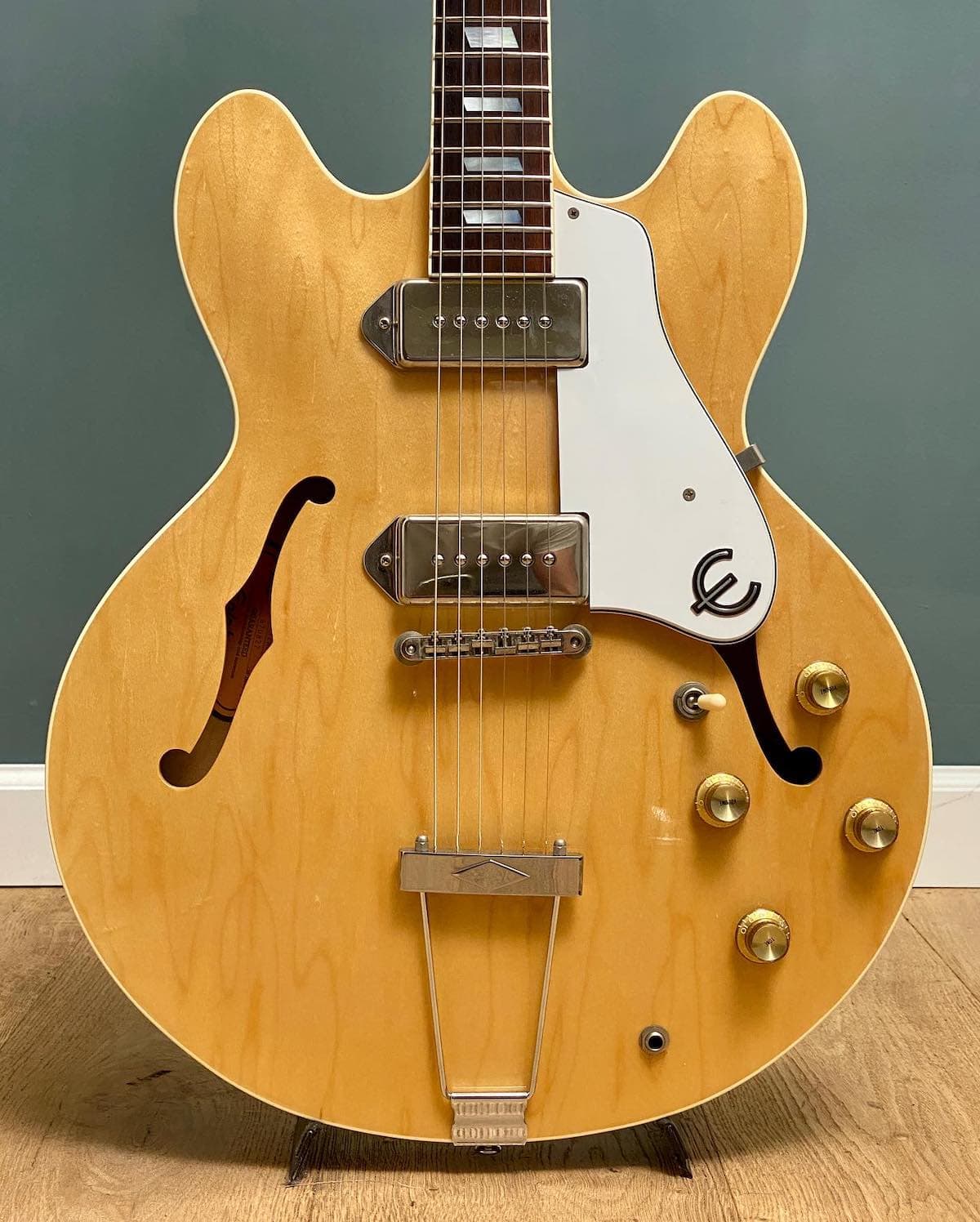
Epiphone Casino - Natural
Upon plugging in I noted that the jack felt a little tight. Standing up to play, the Casino is remarkably light. This is thanks to the Casino’s fully hollow construction: unlike my 335, which has a center block through the middle of its body, the Casino is hollow all the way through.
This gives it a real sense of reverberation as you play it. I really felt the chords in the body of the guitar as I was playing, almost like a great solid-top acoustic.
In fact, it’s loud enough acoustically - that is, unplugged - to facilitate couch practice.
Of course, it’s plugged into an old-school tube amp where the Casino sounds best. It boasts a bright, snappy tone. I couldn’t resist playing some jangly Beatles songs, and the Casino offers great note definition even in denser extended chords. The infamous “Hard Day’s Night” chord in particular sounded awesome!
The bridge P90 also offers enough treble and twang to facilitate some very tasty country playing. It’s a warmer tone than I’d get from a Telecaster, but it’s noticeably brighter than that of a 335.
With a little drive, I was able to get some reliable classic rock crunch, and even chunky pop-punk palm muting going. The downside of having single-coil pickups and a fully hollow guitar is that the Casino is prone to feedback at higher volume and gain levels. I wouldn’t take this guitar to a heavy metal or hard rock gig.
However, for excellent vintage-voiced tones with a different flavor to that of a typical humbucker-equipped hollowbody, it’s hard to argue against the Casino.
Honorable Mentions
There are plenty of great guitars in this price range.
While many mid-range guitars are awesome all-rounders, I’ve discovered a few specialists over the years. I’ve noticed that some of these are very deliberate with where they cut costs. Sometimes, it’s a simple matter of tonewood, hardware, or even country of manufacture.
Take, for example, the shredder’s dream guitar, the Ibanez JEM Jr. It’s Steve Vai’s signature guitar, complete with monkey grip and vine inlay, at a more affordable price point. It shreds, it wails, and looks awesome. It’s just made of cheaper woods and with cheaper than the high-end Vai signature model.
So, too, did Larry Carlton lend his name to a more Superstrat-style guitar, the S7 FM. Like the Vai signature, it feels very shreddy, although its picking voicing is decidedly more Steely Dan than Steel Panther.
I’ve been around country bar bands long enough to recognize a classic Telecaster when I see one, too. The Fender Standard Tele is an Indonesia-made Telecaster, with the twang and power I always associate with this guitar. It almost feels like a customizer’s dream, ready for me to throw in aftermarket pickups, wiring, and hardware just to see if I can.
I’m quite partial to guitars built for heavy music, too, and for this reason I really like the ESP LTD TE-200DX. Unlike its elder brother ESP guitars, this isn’t made in Japan, but I love the rosewood fretboard and jumbo frets. It’s simply ready to rock out: the humbuckers run hotter than my stovetop at home. Check out our review of the LTD TE-200 for a better idea about these guitars.
I would be remiss in discussing great mid-range guitars without throwing an honorable mention to the enduring star of many a budget guitar conversation: Danelectro. In particular, I am a big fan of the simple bridge and the unique lipstick pickups in the 59M semi-hollowbody, mostly because its lack of F holes makes it easier to run at high gain levels than my 335.
Intermediate Guitars: Not Just for Intermediate Players
I’ve always said that a great guitar player can make any instrument sound good. No guitar makes that argument ring truer than an awesome intermediate instrument: often, great guitar players hone their chops on an intermediate axe before going pro.
Some of the greatest guitar work ever recorded was done on an “intermediate” instrument: Slash’s playing on Appetite For Destruction, for example, was almost entirely recorded on a cheap Les Paul copy. He didn’t get a real Gibson Les Paul until after the album came out!
Maybe one of the guitars on this list will inspire you to record your own era-defining hits. They certainly sound, and play, well enough.

